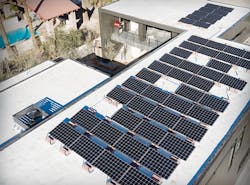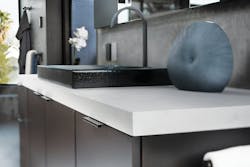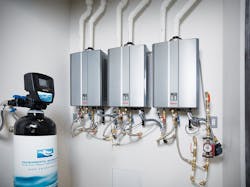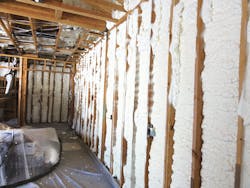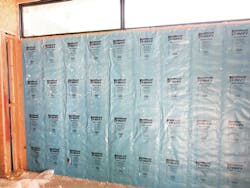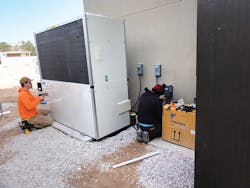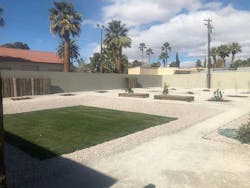Net Zero has long been at the cutting edge of high-performance building and remodeling.
It’s where efficiency in the envelope and the right mechanical and electrical equipment make for such minimal heating and cooling loads that a reasonably sized solar array will generate all the home’s electricity needs, if not more. Depending on the homeowners’ lifestyles, selling that electricity to a utility company can yield a net annual bill of zero dollars, and could even turn a profit.
This year’s New American Remodel features all of those advances, and more. In the end, the home should garner a negative HERS score, meaning that the structure produces more energy than it consumes.
The Rinnai tankless hot water heaters are plumbed to a recirculating loop. Hot water flows as soon as the tap is turned on, so none is wasted while the user waits for it to heat up.
As befits an IBS show home, there are plenty of lessons in creative design. But architect and remodeler Michael Gardner also saw an opportunity to encourage contractors to think more broadly about the concept of sustainability. In that vein, he decided to add a working garden with ample food prep and storage areas. “To me, sustainable design includes energy and water use, food production, and even compost,” says Gardner.
Let’s look at a few of these.
Getting to Zero
Contractors who don’t want to remove drywall can blow cellulose in from the outside then add rigid exterior foam, but a gut remodel offers the best performance results. That was the plan here. The unreinforced block walls in the existing 1950s ranch didn’t meet 21st century structural codes and would need to be supplemented with framed walls anyway. That raised costs but also made it easy to create an R-35 wall system from a combination of open cell foam, a hybrid radiant barrier, and exterior rigid foam.
To reduce waste and cost, insulators sprayed open cell foam into the studbays to just ¾” depth, eliminating the need to trim overfill. Then they stapled Fi-Foil Hy-Fi, a hybrid insulation and radiant barrier, over the studs. This yielded a whole-wall R-value of 35, which was equivalent to a full-foam fill but at less cost.
When it came to air sealing, Drew Smith of Two Trails, the home’s energy consultant, decided against conventional caulks and opted instead for a computer-controlled, aerosol-like sealant.
Doors, windows, and duct grilles—gaps you don’t want to seal—are taped off and the house pressurized with a blower door. When the Aerobarrier, consisting of molecular-sized foam particles, is sprayed into the air, it’s forced by that pressure into the remaining gaps—the ones you want to seal. (The home had not received a final blower door test at this writing, but Smith expects a score of around 2.5 ACH at 50 Pascals.)
The finished project should receive a negative HERS score, denoting a home that produces more energy on an annual basis than it consumes. It will earn certification from LEED, the National Green Building Standard, DOE’s Zero Energy Ready program, and EPA’s Indoor Air Plus program.
Envelope detailing is half the equation when it comes to slashing electric loads; the other half is equipment choice.
All appliances are Energy Star-rated and all light fixtures, including the decorative chandeliers, use LED bulbs. Smith also decided against a standard electric heat pump and instead chose a natural gas-powered unit. It will cost less to run than an electric unit would in this house, but cost effectiveness in other parts of the country will depend on local gas and electric rates. Also, if the power gets interrupted, the homeowners will still have air conditioning.
Gardner wanted to build in as much passive cooling as possible. That’s one motivation behind the home’s layout: a courtyard design that wraps around a central outdoor area with a pool. An obvious part of that passive cooling strategy is the south-facing front wing and big roof overhangs that provide shade to the outdoor rooms. Less obvious is the pool’s contribution.
In summer, the pool is in direct sunlight for much of the day. The evaporation acts as a humidifier for the surrounding spaces—much needed in Vegas’s dry, desert climate—and helps lower the temperature, but only by a bit. Gardner and Smith call the pool an “evaporative cooler.”
The 15-ton heat pump condenser is powered by natural gas rather than electricity. It uses Variable Refrigerant Volume technology, which allows one condenser to serve multiple indoor units and controls the temperature in each room by varying the flow of refrigerant to the indoor unit.
The evaporative process also creates some circulation. “If you open the sliders correctly, convective movement could create up to a 5 mph breeze, which is like fan,” he says. Which doors to open, and how much, will vary with conditions that include the time of day and wind speed. “As people live in the house, they will learn what works best when.”
Garden Home
The backyard garden has been laid out to optimize yield and to support what’s often called farm-to-table living. Yes, that’s a fancier, more modern spin on how most people lived for centuries (and in some places still do), when everyone cultivated food out of necessity. We don’t expect this house will be occupied by farmers, but there are other motivations today, specifically environmental and health concerns, that keep this sort of living in demand.
A garden plan includes vegetables, as well as fruit and nut trees that will yield an abundant harvest. A covered walkway between the garage and casita make for easy access to the utility room prep sink, as well as the pantry and the kitchen.
Pesticides, for instance, are something that have people keeping a closer eye on their food and where it comes from. Most of us walk around with 29 different pesticides in our system, thanks in part to food from large-scale agribusiness, according to a Consumer Reports study. An organic garden means chemical-free fruits and veggies.
While most home gardens are an afterthought, the New American Remodel was designed with urban farming in mind. There’s a direct, covered passage to the pantry and kitchen, and multiple prep sinks for washing and peeling the harvest. There’s even an urban cultivator—a refrigerated unit for growing herbs—in the pantry.
Each of the two large refrigerators and freezers in the kitchen has its own compressor (four total). The airstreams from the refrigerator and freezer don’t mix, so that food will stay fresh longer.
Basically, the home offers a measure of independence in terms of energy and food. Gardner hopes its lessons will help builders and remodelers better serve contemporary homeowners who are concerned about the environment, their monthly bills, and their health.
About the Author
Charlie Wardell
Charlie Wardell is a freelance writer and former remodeler in Tisbury, Mass.
